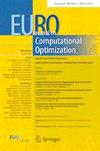Finding quadratic underestimators for optimal value functions of nonconvex all-quadratic problems via copositive optimization
IF 2.6
Q2 OPERATIONS RESEARCH & MANAGEMENT SCIENCE
引用次数: 0
Abstract
Modeling parts of an optimization problem as an optimal value function that depends on a top-level decision variable is a regular occurrence in optimization and an essential ingredient for methods such as Benders Decomposition. It often allows for the disentanglement of computational complexity and exploitation of special structures in the lower-level problem that define the optimal value functions. If this problem is convex, duality theory can be used to build piecewise affine models of the optimal value function over which the top-level problem can be optimized efficiently. In this text, we are interested in the optimal value function of an all-quadratic problem (also called quadratically constrained quadratic problem, QCQP) which is not necessarily convex, so that duality theory can not be applied without introducing a generally unquantifiable relaxation error. This issue can be bypassed by employing copositive reformulations of the underlying QCQP. We investigate two ways to parametrize these by the top-level variable. The first one leads to a copositive characterization of an underestimator that is sandwiched between the convex envelope of the optimal value function and that envelope's lower-semicontinuous hull. The dual of that characterization allows us to derive affine underestimators. The second parametrization yields an alternative characterization of the optimal value function itself, which other than the original version has an exact dual counterpart. From the latter, we can derive convex and nonconvex quadratic underestimators of the optimal value function. In fact, we can show that any quadratic underestimator is associated with a dual feasible solution in a certain sense.
利用组合优化方法寻找非凸全二次问题最优值函数的二次低估量
将优化问题的部分建模为依赖于顶层决策变量的最优值函数是优化中经常出现的情况,也是Benders分解等方法的基本组成部分。它通常允许解开计算复杂性的纠缠,并在定义最优值函数的较低级问题中利用特殊结构。如果该问题是凸的,则可以利用对偶理论建立最优值函数的分段仿射模型,从而有效地优化顶层问题。在本文中,我们感兴趣的是一个不一定是凸的全二次问题(也称为二次约束二次问题,QCQP)的最优值函数,因此对偶理论不能在不引入一般不可量化的松弛误差的情况下应用。这个问题可以通过使用基础QCQP的复合重新表述来绕过。我们研究了两种方法来参数化这些顶层变量。第一个导致低估者的合成特征,该低估者夹在最优值函数的凸包络和该包络的下半连续外壳之间。这种特性的对偶性使我们能够推导出仿射低估量。第二个参数化产生最优值函数本身的另一种特征,与原始版本不同,它具有精确的对偶对应。由后者,我们可以得到最优值函数的凸和非凸二次低估量。事实上,我们可以证明,在某种意义上,任何二次低估量都与对偶可行解相关联。
本文章由计算机程序翻译,如有差异,请以英文原文为准。
求助全文
约1分钟内获得全文
求助全文
来源期刊

EURO Journal on Computational Optimization
OPERATIONS RESEARCH & MANAGEMENT SCIENCE-
CiteScore
3.50
自引率
0.00%
发文量
28
审稿时长
60 days
期刊介绍:
The aim of this journal is to contribute to the many areas in which Operations Research and Computer Science are tightly connected with each other. More precisely, the common element in all contributions to this journal is the use of computers for the solution of optimization problems. Both methodological contributions and innovative applications are considered, but validation through convincing computational experiments is desirable. The journal publishes three types of articles (i) research articles, (ii) tutorials, and (iii) surveys. A research article presents original methodological contributions. A tutorial provides an introduction to an advanced topic designed to ease the use of the relevant methodology. A survey provides a wide overview of a given subject by summarizing and organizing research results.
 求助内容:
求助内容: 应助结果提醒方式:
应助结果提醒方式:


